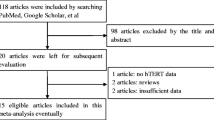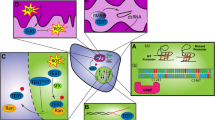Abstract
Telomerase reverse transcriptase (TERT) encodes the catalytic subunit of telomerase. The role of TERT in gliomagenesis has been extensively investigated. Since the influence of district, population, sample size, and experimental technology, our analysis, based on published articles, was aimed to obtain an accurate estimation of the relationship between TERT mutations and prognosis of glioma patients. PubMed, Web of science and Google Scholar databases were searched for potential articles. Finally, six studies with 2111 patients were included in the meta-analysis. Heterogeneity was evaluated by I2 statistics and P value. I2 > 50 % and P < 0.05 indicated significant heterogeneity between included studies and random-effects model was used; otherwise, fixed-effects model was used for analysis. The results of meta-analysis was expressed as hazard ratio (HR) and 95 % confidence interval (CI). The pooled results calculated by fixed-effects model suggested that TERT mutations were associated with poor prognosis of glioma patients (HR 1.68, 95 % CI 1.43–1.97). In conclusion, TERT mutations may be associated with shorter survival of glioma patients.



Similar content being viewed by others
References
Ostrom QT et al (2013) CBTRUS statistical report: primary brain and central nervous system tumors diagnosed in the United States in 2006–2010. Neuro Oncol 15(Suppl 2):ii1–ii56
Weller M et al (2014) EANO guideline for the diagnosis and treatment of anaplastic gliomas and glioblastoma. Lancet Oncol 15(9):e395–e403
Oike T et al (2013) Radiotherapy plus concomitant adjuvant temozolomide for glioblastoma: Japanese mono-institutional results. PLoS One 8(11):e78943
Giardini MA et al (2014) Telomere and telomerase biology. Prog Mol Biol Transl Sci 125:1–40
Cesare AJ, Reddel RR (2010) Alternative lengthening of telomeres: models, mechanisms and implications. Nat Rev Genet 11(5):319–330
Kim NW et al (1994) Specific association of human telomerase activity with immortal cells and cancer. Science 266(5193):2011–2015
Shay JW, Bacchetti S (1997) A survey of telomerase activity in human cancer. Eur J Cancer 33(5):787–791
Tahara H et al (1999) Immuno-histochemical detection of human telomerase catalytic component, hTERT, in human colorectal tumor and non-tumor tissue sections. Oncogene 18(8):1561–1567
Borah S et al (2015) Cancer. TERT promoter mutations and telomerase reactivation in urothelial cancer. Science 347(6225):1006–1010
Melo M et al (2015) Coexistence of TERT promoter and BRAF mutations in papillary thyroid carcinoma: added value in patient prognosis? J Clin Oncol 33(6):667–668
Cevik D, Yildiz G, Ozturk M (2015) Common telomerase reverse transcriptase promoter mutations in hepatocellular carcinomas from different geographical locations. World J Gastroenterol 21(1):311–317
Ma X et al (2014) Recurrent TERT promoter mutations in non-small cell lung cancers. Lung Cancer 86(3):369–373
Griewank KG et al (2014) TERT promoter mutation status as an independent prognostic factor in cutaneous melanoma. J Natl Cancer Inst 106(9)
Melo M et al (2014) TERT promoter mutations are a major indicator of poor outcome in differentiated thyroid carcinomas. J Clin Endocrinol Metab 99(5):E754–E765
Qu Y et al (2014) TERT promoter mutations predict worse survival in laryngeal cancer patients. Int J Cancer 135(4):1008–1010
Killela PJ et al (2014) Mutations in IDH1, IDH2, and in the TERT promoter define clinically distinct subgroups of adult malignant gliomas. Oncotarget 5(6):1515–1525
Killela PJ et al (2013) TERT promoter mutations occur frequently in gliomas and a subset of tumors derived from cells with low rates of self-renewal. Proc Natl Acad Sci U S A 110(15):6021–6026
Koelsche C et al (2013) Distribution of TERT promoter mutations in pediatric and adult tumors of the nervous system. Acta Neuropathol 126(6):907–915
Arita H et al (2013) Upregulating mutations in the TERT promoter commonly occur in adult malignant gliomas and are strongly associated with total 1p19q loss. Acta Neuropathol 126(2):267–276
Li G et al (2012) Selected polymorphisms of GSTP1 and TERT were associated with glioma risk in Han Chinese. Cancer Epidemiol 36(6):525–527
Simon M et al (2015) TERT promoter mutations: a novel independent prognostic factor in primary glioblastomas. Neuro Oncol 17(1):45–52
Chen C et al (2014) TERT promoter mutations lead to high transcriptional activity under hypoxia and temozolomide treatment and predict poor prognosis in gliomas. PLoS One 9(6):e100297
Labussiere M et al (2014) TERT promoter mutations in gliomas, genetic associations and clinico-pathological correlations. Br J Cancer 111(10):2024–2032
Nonoguchi N et al (2013) TERT promoter mutations in primary and secondary glioblastomas. Acta Neuropathol 126(6):931–937
Labussiere M et al (2014) Combined analysis of TERT, EGFR, and IDH status defines distinct prognostic glioblastoma classes. Neurology 83(13):1200–1206
Wright WE et al (1996) Telomerase activity in human germline and embryonic tissues and cells. Dev Genet 18(2):173–179
Harley CB (1991) Telomere loss: mitotic clock or genetic time bomb? Mutat Res 256(2–6):271–282
Shay JW, Wright WE (2001) Ageing and cancer: the telomere and telomerase connection. Novartis Found Symp 235:116–125, discussion 125–9, 146–9
Cohen SB et al (2007) Protein composition of catalytically active human telomerase from immortal cells. Science 315(5820):1850–1853
Greider CW, Blackburn EH (1987) The telomere terminal transferase of Tetrahymena is a ribonucleoprotein enzyme with two kinds of primer specificity. Cell 51(6):887–898
Nakamura TM et al (1997) Telomerase catalytic subunit homologs from fission yeast and human. Science 277(5328):955–959
Nakayama J et al (1998) Telomerase activation by hTRT in human normal fibroblasts and hepatocellular carcinomas. Nat Genet 18(1):65–68
Fujimoto K, Takahashi M (1997) Telomerase activity in human leukemic cell lines is inhibited by antisense pentadecadeoxynucleotides targeted against c-myc mRNA. Biochem Biophys Res Commun 241(3):775–781
Wu KJ et al (1999) Direct activation of TERT transcription by c-MYC. Nat Genet 21(2):220–224
Su J et al (2015) Stanniocalcin-1, a new biomarker of glioma progression, is associated with prognosis of patients. Tumour Biol 36(8):6333–6339
Vieira de Castro J et al (2015) Impact of TGF-beta1 -509C/T and 869T/C polymorphisms on glioma risk and patient prognosis. Tumour Biol
Sun G et al (2015) Decreased expression of miR-15b in human gliomas is associated with poor prognosis. Cancer Biother Radiopharm 30(4):169–173
Yeung YT et al (2013) Interleukins in glioblastoma pathophysiology: implications for therapy. Br J Pharmacol 168(3):591–606
Shan Y et al (2015) Role of IL-6 in the invasiveness and prognosis of glioma. Int J Clin Exp Med 8(6):9114–9120
Ichimura K (2012) Molecular pathogenesis of IDH mutations in gliomas. Brain Tumor Pathol 29(3):131–139
Mosrati MA et al (2015) TERT promoter mutations and polymorphisms as prognostic factors in primary glioblastoma. Oncotarget 6(18):16663–16673
Park CK et al (2014) Expression level of hTERT is regulated by somatic mutation and common single nucleotide polymorphism at promoter region in glioblastoma. Oncotarget 5(10):3399–3407
Spiegl-Kreinecker S et al (2015) Prognostic quality of activating TERT promoter mutations in glioblastoma: interaction with the rs2853669 polymorphism and patient age at diagnosis. Neuro Oncol 17(9):1231–1240
Author information
Authors and Affiliations
Corresponding author
Ethics declarations
Competing Interests
The authors declare that they have no competing interests.
Additional information
Peiliang Geng and Xiaoxin Zhao are co-first authors.
Rights and permissions
About this article
Cite this article
Geng, P., Zhao, X., Ou, J. et al. TERT Genetic Mutations as Prognostic Marker in Glioma. Mol Neurobiol 54, 3665–3669 (2017). https://doi.org/10.1007/s12035-016-9930-2
Received:
Accepted:
Published:
Issue Date:
DOI: https://doi.org/10.1007/s12035-016-9930-2




